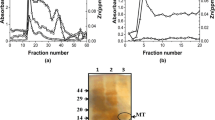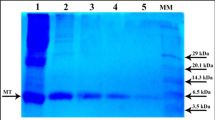Abstract
Metallothionein (MT) a low molecular weight, Cd-binding, cysteine rich, cytosolic protein has been isolated, purified and characterized from cadmium exposed Rhesus monkeys maintained on protein calorie malnourished (PCM) diet. Metallothionein was resolved into three isoforms i.e. MTa, MTb and MTVc. The ratio of Cd, Zn and Cu varied in these isometallothioneins. MTc was the major isometallothionein. UV Spectra of MTc revealed the presence of mercaptide bonds and absence of aromatic amino acids. These observations were further confirmed by amino acid analysis of MTc which demonstrated high cysteine content (22.6) followed by serine, glycine and lysine. The molecular weight of MTc as determined by gel filtration and amino acid analysis was 13000 and 6398 daltons respectively. This demonstrates that MTc is a non-globular ellipsoid polypeptide. MTc showed a unique property of binding selenium. Monkey liver metallothionein was immunologically identical with human metallothionein. All the characteristics of MTc obtained in the present study reveal a similarity between monkey and human metallothionein probably due to closer phylogenetic relationship between the two species.
Similar content being viewed by others
References
Kagi JHR, Vallee BL: Metallothionein: A cadmium and Zn containing protein from equine renal cortex. J Biol Chem 235:3460–3465, 1960.
Piscator M: On cadmium in normal human kidneys together with a report on the isolation of metallothionein from livers of cadmium exposed rabbits. Nord Hyg Tidsk 45:76–82, 1964.
Udom AO, Brady FO: Reactivation in vitro of zinc binding apo-enzymes by rat liver zinc thionein. Biochem J 187:329–335, 1980.
Karin M: Metallothionein: Proteins in search of function. Cell 41(1):9–10, 1985.
Margoshes M, Vallee BL: Cadmium binding protein from equine kidney cortex. J Am Chem Soc 79:4813–4814, 1957.
Pulido P, Kagi JHR, Vallee BL: Isolation and some properties of human metallothionein. Biochemistry 5:1768–1777, 1966.
Buhler RHO, Kagi JHR: Human hepatic metallothioneins. Febs Lett 39:229–234, 1974.
Shaikh ZA, Lucis OJ: Isolation of Cd-binding protein. Experientia 27:1024–1025, 1971.
Winge DR, Rajagopalan KV: Purification and some properties of Cd-binding protein from rat liver. Arch Biochem Biophys 153:755–762, 1972.
Nordberg GF, Nordberg M, Piscator M, Vesterberg O: Separation of two forms of rabbit metallothionein by isoelectric focussing. Biochem J 126:491–498, 1972.
Bremner I, Young BW: Copper thionein in the kidneys of copper-poisoned sheep. Chem Biol Interact 19:13–23, 1977.
Bremner I, Young BW: Isolation of (copper, zinc) thioneins from pig liver. Biochem J 155:631–635, 1976.
Lee SS, Mate BR, Von der Trenk KT, Riemerman RA, Buhler DR: Metallothionein and the subcellular localization of mercury and cadmium in the California sea lion. Comp Biochem Physiol 57:C45–53, 1977.
Weser U, Rupp H, Donay F, Linneman F, Voelter W, Voetsch W, Jung G: Characterization of Cd, Zn thionein (metallothionein) isolated from rat and chicken liver. Eur J Biochem 39:127–140, 1973.
Chakrabarty T, Maiti IB: Immunological and biochemical properties of metallothioneins of golden hamsters, mouse and rat. Mol Cell Biochem 68:41–47, 1985.
Schales O, Schales SS: A simple and accurate method for the determination of chloride in biological fluids. J Biol Chem 140:879–884, 1941.
Onosaka S, Cherian MG: Comparison of metallothionein. Determination by polarographic and cadmium saturation methods. Toxicol Appl Pharmacol 63:270–274, 1982.
Davis BJ: Disc electrophoresis — II. Method and application to human serum proteins. Ann NY Acad Sci 121:248–254, 1964.
Vander Mallie RJ, Garvey JS: Production and study of antibody produced against rat cadmium thionein. Immunochemistry 15:857–868, 1978.
Ouchterlony O: In: Kallos P (ed) Progress in Allergy, Vol V. Karger, Basel, New York, 1958, pp 1–28.
Kagi JHR, Vallee BL: Metallothionein, a Cd and Zn containing protein from equine renal cortex. J Biol Chem 236(3):2435–2442, 1961.
Prasad R: Study of cadmium toxicity on intestine and kidney of monkey subjected to protein calorie malnutrition. Ph.D. Thesis PGIMER, Chandigarh, India, 1984.
Paliwal VK, Kambadur R, Prasad R, Nath R: Effects of protein calorie malnutrition and calcium deficiency on hepatic iso-metallothioneins in Cd-exposed monkeys. Biochem Int 11(3):397–405, 1985.
Paliwal VK, Lyall V, Prasad R, Gulati S, Sharma M, Nath R: Purification and characterization of monkey kidney cadmium metallothionein and its selenium binding properties. Biochem Int 4(4):399–408, 1982.
Suzuki KT, Maitani T: Metal dependent properties of metallothionein: Replacement in vitro of zinc in zincthionein with copper. Biochem J 199:289–295, 1981.
Cain K, Holt DE: Metallothionein degradation: Metal composition as a controlling factor. Chem Biol Interact 28:91–106, 1979.
Law AYC, Stillman MJ: The effect of pH on Cd2+ binding to rat liver metallothionein. Biochem Biophys Res Commun 94:138–143, 1980.
Kagi JHR, Himmelhoch SR, Whanger PD, Bethune JL, Vallee BL: Equine hepatic and renal metallothioneins. Purification, molecular weight, amino acid composition, and metal content. J Biol Chem 249:3537–3542, 1974.
Kissling, MM, Kagi JHR: Primary structure of human hepatic metallothionein. FEBS Lett 82(2):247–250, 1977.
Perler F, Eftratiodis A, Lomedico QP, Gilbert W, Kolodner R, Dodgson: The evolution of genes. The chicken preproinsulin gene. Cell 20:555–566, 1980.
Schmidt CJ, Hamer DH: Cloning and sequence analysis of two monkey metallothionein cDNAs. Gene 24:137–146, 1983.
Kar AB, Das RP, Mukerji B: Prevention of cadmium induced changes in the gonads of rat by zinc and selenium. A study in antagonism between metals in the biological systems. Proc Natl Acad Sci (India) Part B 26, Suppl 40, 1960.
Chen RW, Whanger PD, Weswig PH: Biological function of metallothionein: Synthesis and degradation of rat liver metallothionein. Biochem Med 12:95–105, 1975.
Gunn SA, Gould TC, Anderson WAD: Mechanisms of zinc, cysteine and selenium protection against cadmium induced vascular injury to mouse testis. J Reprod Fertil 15:65–70, 1968.
Author information
Authors and Affiliations
Rights and permissions
About this article
Cite this article
Paliwal, V.K., Kohli, K.K., Sharma, M. et al. Purification and characterization of metallothionein from liver of cadmium exposed Rhesus monkeys (Macaca mulatta). Mol Cell Biochem 71, 139–147 (1986). https://doi.org/10.1007/BF00214773
Received:
Issue Date:
DOI: https://doi.org/10.1007/BF00214773




